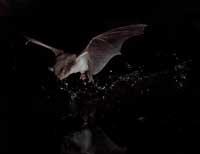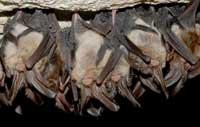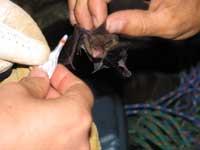Looking at the fishing of the long bat

The bat milestone is fisherman in 2003. During the dietary analysis of this species, the researchers discovered in their excrements the vertebrae and scales of the fish. His relationship with several colleagues from Valencia allowed a group of UPV researchers to participate in this surprising discovery. Not only in Valencia, but also in Italy and Palestine.
Thus it was shown that this species is fed by fish, but it was also intended to verify that bats captured fish by themselves, for which an experiment was conducted in 2005. The animals remained under control for a few days in a cage shop, when they showed that these bats were able to catch and eat live fish.

Now the researchers have gone further. Also in nature, on the mountain, they have seen that the wet bat does the same: through high speed and infrared videos, they have been able to record the cynegetic activity (the ultrasounds of bats have also been recorded). Not only the nearby media, but also prestigious publications like National Geographic. The UPV-EHU considers that all the documentation compiled “will provide us with a lot of information about this behavior, both ecological and animal adaptation.”
In fact, the diet of these bats is based on surface insects. But, as the members of the UPV-EHU have mentioned, there is an ecological reason to explain the behavior of fishing: “When the wells are drying up and the fish are concentrated on the surface, this resource becomes accessible and is exploited.”
Threatened species
At present in the Basque Country there are identified 27 species of bats. Just two decades ago, however, there was hardly any documentation about it. This is a sample of the work done by the UPV/EHU research team that analyzes the ecology and evolution of bat behavior since the 1990s. Joxerra Aiartza, current leader of the group, took his first steps in the development of the Atlas of the distribution of bat species in the ACBC. Subsequently, nine biologists met.

From the study of Aiartza, the group specialized in the analysis of the selections of habitat and diet. For this purpose they use radiotelemetry: after placing very special radio emitters to the animals, the bats are released again in the cave. “The next night, when they go to eat, we follow them. We know how much and when they move and in what habitats they graze.”
The team of the UPV/EHU has been able to know the ecology of bats abroad and, above all, to identify the risk factors that threaten the extinction of bats thanks to an intense work done at home. For example, they know that at least two of the 27 bat species identified in the Basque Country are in danger.
As for the species that inhabit the caves, for example, it is observed that one of the main risk factors is the loss of shelters. It stands out that habitat is also a key factor, since bats need a great variety and abundance of insects to survive. In this sense, human activity goes in the opposite direction: pine management and the use of pesticides, such as dimilina, have caused significant damage.
Published in 7K.
Buletina
Bidali zure helbide elektronikoa eta jaso asteroko buletina zure sarrera-ontzian











